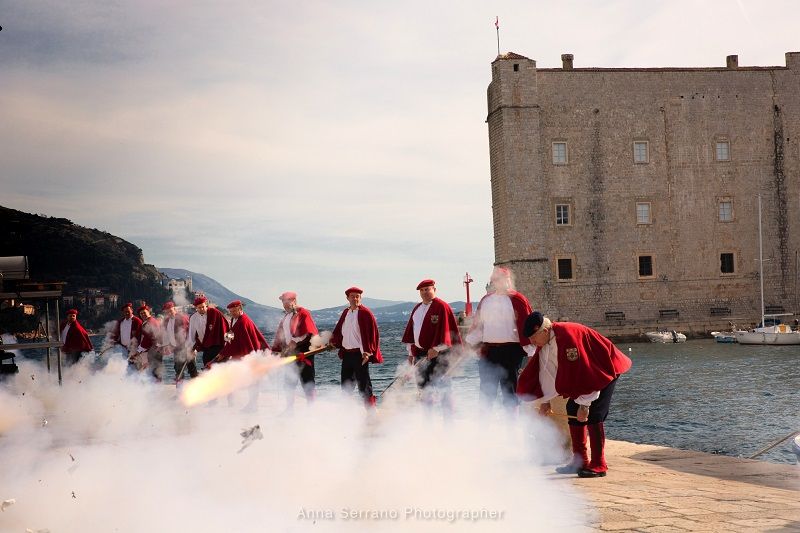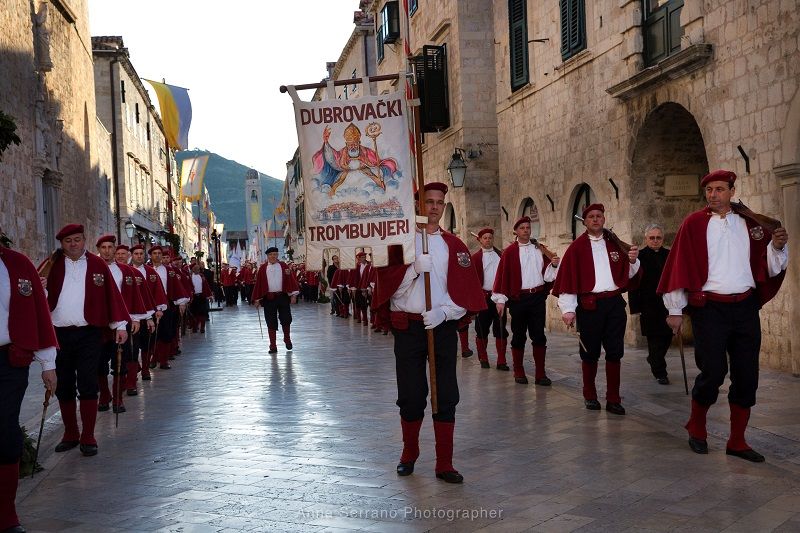Dubrovnik is gearing up for the annual celebration of its patron saint, St. Blaise on February 3, 2017, an event TCN will be covering in depth, as we take a closer look at the considerable attractions of the Pearl of the Adriatic out of season. Our main coverage will start next week, but we begin by taking a closer look at one of the great symbols of the festivals – the muskateers of Dubrovnik – the Trombunjeri.
If you’re in the City of Dubrovnik for the feast day of Saint Blaise, you won’t be able to miss the curious sight of a group of men adorned from head to toe in bright, dramatic uniforms and carrying short, broad rifles on their shoulders. As if straight from the first page of a medieval novel, this colourfully dressed group are the Dubrovnik Trombunjeri, they are an essential part of the festivity of Dubrovnik’s patron saint – one of, if not the most important event in the small, southern Croatian town.
Translated, the word Trombunjeri equates to ”Musketeers” and in short, the gunshot from a Trombunjer makes the town and its people aware of a significant event, this gesture alone is a key part of the events of every February the 3rd. I realise this doesn’t quite cover it, so let’s go into more detail, firstly about the festivity of Saint Blaise itself, and why this group of men in red are such a key part of it.

So, who is Saint Blaise?
Saint Blaise was a 4th century Armenian bishop who, to state the details as far as we understand them, appeared to a man named Stojko (the then pastor of Dubrovnik) as he took an evening stroll on February the 2nd, 971. That evening began just as peacefully and as quietly as the last, moreso because it was Candlemas, the traditional feast of the Presentation of Jesus. A large fleet of Venetian ships were anchored just outside the great city walls, waiting to embark on their journey east. As Stojko steadily approached the Church of Saint Stephen, he noticed something wasn’t quite right as the large doors of the premises had been left wide open, an event which never happens. Worried, Stojko cautiously entered the unlit church as dusk fell and bathed the cold, stone interior in a faint blue light. He came upon the image of a very old man who, when prompted, referred to himself as Saint Blaise. He went on to explain to an astonished and utterly speechless Stojko that the reason for his presence was one of grave warning – that Dubrovnik was faced with a great danger.
The Venetians who had anchored seemingly innocently outside the city walls had arrived under a false pretence, planning all along to attack the unsuspecting city by surprise. Dubrovnik was then a flourishing commercial power and posed a potential threat to the almighty Venice. Stojko, still baffled and hardly believing what he had seen and heard, ran as fast as his feet could carry him to the City Council and warned them desperately of the impending attack. All gates to the city were subsequently closed and secured and men were sent up onto the mighty walls in defence. Upon seeing that Dubrovnik had somehow learned of and thwarted their carefully planned surprise attack, the Venetians abandoned their plot and and readily departed, leaving Dubrovnik (then the Republic of Ragusa) in peace.
Over the many centuries that followed this incredulous event, the relationship between Dubrovnik and the saint has only grown stronger, their mutual identities becoming so cosmically intertwined that they are virtually inextricable. The festivity of Saint Blaise has taken place to some extent or another since the year 1190, with colourful event programs and succeeding generations carefully adapting some parts of the festivities to match the pace of current times, keeping it vibrant, relevant and deeply embedded in Dubrovnik’s unique culture, even in an otherwise increasingly shallow modern world. Today, the image of Saint Blaise can be found all over Dubrovnik, he has churches named after him, as well as statues of his likeness cradling the Old City of Dubrovnik protectively in his hand posed proudly the imposing city walls. His spirit can be felt everywhere, and it was he who answered the prayers of desperate people as recently as the 1990’s during the barbaric Siege of Dubrovnik. In 2009, the feast of Saint Blaise was inscribed on UNESCO’s List of Intangible Heritage.

With that out of the way, who are the Trombunjeri?
The Trombunjeri are a historical military formation and unit, armed with specific firearms known as ”trombuni”. They are a key part of all significant events held in Dubrovnik and also in other parts of Croatia, participating in events like Varazdin’s Spancirfest and in the parade of the celebration of the Day of Pozega as recently as 2016. But their most important and well-known role is unarguably the place they take during the festivity of Saint Blaise and the Day of the City of Dubrovnik. The Trombunjeri have made their mark as the heartbeat and the lungs of all major happenings in the area for longer than living memory can speak of. Founded in the year 1417, the Trombunjeri are responsible for guiding the procession of celebrants which marches through the Old City, their presence immediately turning the clock back through history, delighting locals and visitors alike. The Commander is Stjepan Masle, the secretary is Ivan Grbic, the current actual President is Tomislav Macan, and Perennial President of the Musketeers (Visegodisnji Predsjednik Trombunjera) is Antun Knego, who is also a knight of the European Order of Saint Sebastian. The Trombunjeri themselves have belonged to the Union of Historical Units of the Croatian Army and historical forces of Europe since the year 2005.
During the Croatian War of Independence, the situation in Dubrovnik was far from stable, meaning the traditional firing of the guns could not take place for fear of being misinterpreted as hostile, instead, in 1992 the procession was led with olive branches placed inside the rifle barrels in a distinct sign of the advocation of peace. The Trombunjeri are not permitted to actively use firearms inside the walls, and begin by firing in salute on Brsalje (Pile), at the western entrance to the Old City in the early morning of February the 3rd. Originally, the present day Brsalje street was where the shooting of cannons, rifles and other weaponry was practiced, used to create substantial noise and intimidate enemies of Dubrovnik during the time of the autonomous Republic.
The Trombunjeri are wildly popular and have around 25 gigs all over the country each year, 15 of which are in Dubrovnik, with the remaining 10 taking them to other cities in which they are part of parades and pilgrimages.
Loved by all and holding a more than special place in the hearts of locals, the spirited Trombunjeri, made up of 55 active members, are an integral part of the culture and indeed the identity of the eternally unique City of Dubrovnik.
The Dubrovnik Trombunjeri have launched a website in time for this year’s St. Blaise celebrations. Learn more about the Dubrovnik Trombunjeri here.







